
This gal and her herd help keep Hillside’s dairy store stocked with fresh milk and ice cream. In addition to the cows, the farm also boasts goats, sheep, donkeys, pigs, alpacas, chickens, ducks, and even a peacock!
A hundred years ago, the United States Motion Picture Corporation (USMPC) lugged its bulky filming equipment to Hillside Farms in Shavertown, about five miles outside of Wilkes-Barre. Their mission: record actress Leatrice Joy, who played Sue in Her Fractured Voice, serenading a herd of cows. Fast-forward to 2017, when I was heading to Hillside Farms, equipped with a slim iPhone that contained more filming technology than USMPC could have ever imagined. My mission: grab some shots of the historic barns and iconic Hillside cows.
The first time I watched Her Fractured Voice, the barnyard scene caught my attention. As the cows fled from Sue’s awful singing, I wondered if it was filmed at Hillside Farms. It was a desperate guess at the only area farm I knew. However, I quickly dismissed the idea. In the early twentieth century, hundreds of dairy farms dotted the Wyoming Valley. What were the chances that the farm from Her Fractured Voice happened to be one of the only surviving ones?

The main barnyard instantly reminded me of the scene from Her Fractured Voice. I wonder how the crew got the cows to flee from Sue’s voice at just the right moment.
As I read up on the Black Diamond Comedies, I discovered that my guess was correct. I probably shouldn’t have been so surprised. After all, Hillside was a stylish place at the time of the filming. In the 1880s, coal broker William Conyngham of Wilkes-Barre began buying small farms in the Back Mountain, which he transformed into a summer estate and commercial dairy. His country getaway included a 34-room Victorian cottage, rare Lord & Burnam greenhouses, and award-winning Clydesdale horses. Yet despite all of these star-worthy amenities, the dairy cows got to share the spotlight with Sue.
The property remained in the Conyngham family until 2009, when it was purchased by the Lands at Hillside Farms, a nonprofit that promotes sustainable living.
Today, a visit to Hillside Farms is like taking a step back in time. Many of the historic buildings have been preserved, and it is still a working dairy farm. The Lands at Hillside Farms also uses old-fashioned farming practices that are healthy for the animals, planet, and consumers. The animals graze in pastures and spacious barnyards, just like they did when USMPC made their visit.
One of the best sights is the daily cow crossing, when farmhands drive the dairy cows across the road to the meadow. The cars have to stop as the herd moseys across the street, cows and drivers mutually gawking at one another. It’s a perfect representation of what Hillside stands for. It’s a place to slow down and appreciate our area’s agricultural heritage.

Although many historic buildings (such as the carriage barn pictured above) still survive on Hillside’s 412-acre property, the barn featured in Her Fractured Voice seems to no longer exist.
For the most part, Hillside is still true to its historical roots. However, instead of being an exclusive gentlemen’s retreat, it is now open to the community. The public can visit the historic buildings and learn about agricultural science, eco-friendly living, and healthy choices. And based off of the popularity of the dairy store and ice cream parlor, it seems like the cows are still the stars of the show!
My family and I visit Hillside Farms often to buy milk and ice cream (coconut is my top choice, pumpkin comes in at a close second). I never tire of exploring the greenhouses, stocking up on local goodies at the dairy store, and visiting the animals. Seriously, who can resist petting the fuzzy baby cows in the calf barn? I’m also a fan of alpacas, and I was elated when I found out that Hillside had a pair of these quirky, South American pack animals. My love for them began when I learned about them in middle school, and still today, a visit to the farm is never complete without stopping by their enclosure.
Although Hillside has always held a spot in my heart, the farm took on a new meaning to me after watching the film. Most locals will say that Hillside is one of the Back Mountain’s historical gems, but many don’t know about its links to the silver screen.
After watching the film, I made a special visit to Hillside. It was a November morning, and no one was down at the barns except for a few volunteers. I took a peaceful walk to the carriage barn, the main building across from the dairy store where the farm keeps a few goats, donkeys, and pigs. I stepped out to the barnyard, trying to imagine how the USMPC crew sized up the grounds. A cow was standing right near the door, and I couldn’t help but crouch down and snap a photo.
“Hi, buddy. I won’t sing at you, I promise,” I greeted. My voice is probably more atrocious than Sue’s, and people would definitely question my sanity.
I left feeling refreshed. It’s amazing to know that our area’s history is preserved on film, but seeing how the traditions still survive was truly humbling.
]]>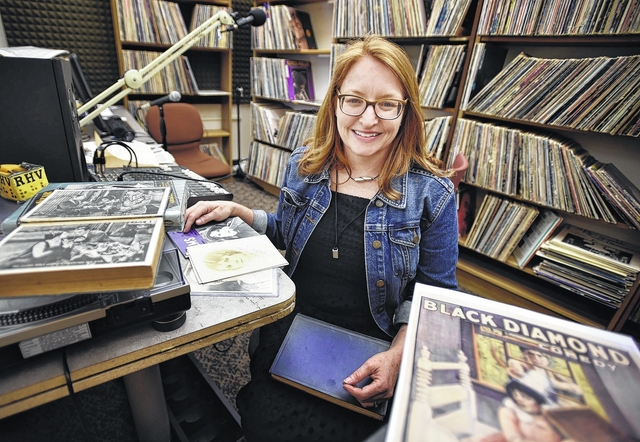
King’s College Professor Noreen O’Connor displays some of her research materials on local film history in the college radio studio, where she broadcasts a weekly radio show. (Photo: Aimee Dilger, Times Leader)
The Wyoming Valley was once home to a motion picture studio, and folks this weekend will have an opportunity to watch one of the silent films made here, along with a Hollywood classic.
Families for Forty Fort Park will present the 1917 film “Susie Slips One Over” at an “Adult Night” Movie in the Park on Friday, followed by a showing of “Casablanca.”
The silent movie was filmed at a studio on Slocum Street in Forty Fort by the United States Motion Picture Corporation, and produced at the company’s offices in Wilkes-Barre in October 1917, said Forty Fort Mayor Andy Tuzinski.
“It’s known as a ‘Black Diamond Comedy,’ referring to the coal mining in the area. The Black Diamond Express was a Lehigh Valley Railroad train,” Tuzinski noted.
“I’m very interested in local history, and this is something I’ve known about for years,” the mayor said, adding that he thought an “Adult Night” for Forty Fort’s “Movie in the Park” series would be the perfect venue to show a film produced in the borough.
When Tuzinski contacted the Luzerne County Historical Society about borrowing a copy of the film, he learned that King’s College English Professor Noreen O’Connor had a copy she obtained from UCLA Film Archive and had been researching.
Enter the professor
O’Connor said she has been researching the history of locally-produced films — made when the East Coast was still home to the movie industry before it moved to Hollywood — about five years ago, after Tony Brooks, then director of the county historical society, spoke to one of her classes and mentioned that the local film company had a listing on the Internet Movie Database (www.IMDb.com).
“This was kind of like the first Hollywood,” O’Connor said of the New York/New Jersey/Pennsylvania tri-state area.
O’Connor said she presented two of the Black Diamond films last October at the Black Bear Film Festival in Milford. She brought along a musician accompanist who played guitar with the films, and then she answered questions.
She would have offered a similar presentation on Friday in Forty Fort, but she has a business trip scheduled for that day, she said.
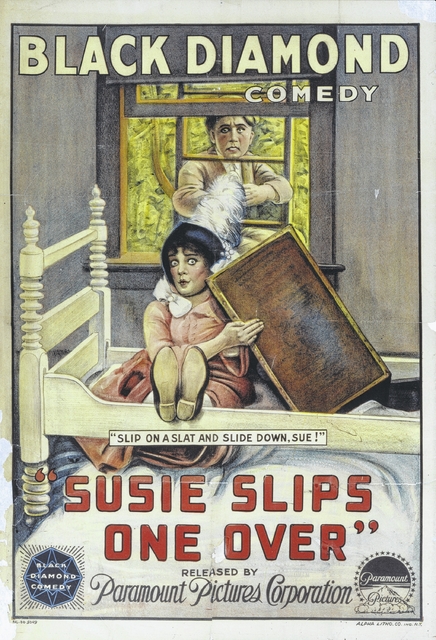
A movie poster for the Black Diamond comedy ‘Susie Slips One Over’ is among the local film artifacts that King’s College Professor Noreen O’Connor has collected in her research.
On the local set
Between Oct. 2, 1916 and Nov. 12, 1917, the United States Motion Picture Corporation produced and released 27 Black Diamond Comedies, O’Connor said.
The one-reel silent films were the first comedies distributed by Paramount Pictures, which was then based in New York. Paramount advertised these comedies widely in 1917. Though most of the films themselves are now lost, the films’ advertisements appear in publications such as The Moving Picture World magazine, and copyright information is held at the Library of Congress, O’Connor noted.
After the company ended its contract with Paramount Pictures in 1917, USMPC released six additional one-reel comic films as Unique Comedies, which were distributed by the Arrow Film Company of New York. These appear to be films originally created for release as Black Diamond Comedies. The company offices for USMPC were in Wilkes-Barre, but the actual film studio was in Forty Fort on Slocum Street, she said.
The films often followed a comic character named Susie, portrayed by USMPC’s leading lady Leatrice Joy, through mishaps and blunders.
The movie star
Leatrice Joy went on to great success in Hollywood as a leading lady for Cecil B. DeMille in epic films such as “The Ten Commandments,” starring Charlton Heston and Yul Brenner. (Small correction–Joy appeared in the 1923 silent version of “The Ten Commandments,” directed by Cecil B. DeMille, and written by Jeanie MacPherson.)
Joy was a well-known actress with a “flapper” persona in the 1920s, and she was one of the silent stars whose career continued beyond the introduction of “talkies” as well. She has a star on the Hollywood Walk of Fame.
O’Connor also noted that the comedy “His Neglected Wife,” which also stars Joy, was discovered with many other old films in a vault in New Zealand and was returned to the United States for restoration at George Eastman House in 2010. Local historian Charles Petrillo helped pay for the restoration.
The film features images of Forty Fort as well as the historic Hotel Sterling in Wilkes-Barre, which was torn down in 2013. In the film, Leatrice Joy’s character checks in to the Sterling and signs the register with “Susie from Forty Fort.”
The film “Susie Slips One Over” in addition to being shot in Forty Fort was probably also made in part at Hillside Farms in the Back Mountain.
Summer of fun
Tuzinski said he thinks that in addition to offering attendees a glimpse at the Wyoming Valley’s local film history, Friday’s “Adult Night” also will provide some great entertainment with “Casablanca” as the feature film.
“I think a lot of people have never seen it. They know the cultural reference, so I thought It’d be a good movie to show,” Tuzinski said.
Set-up will begin around 8 p.m. and the movies will start at dusk.
And movies aren’t the only special events this summer at the park.
Tuzinski noted that the Forty Fort Pool will host a Christmas in July Party beginning at 1 p.m. Saturday. Last Friday, the park committee presented a family movie night with “How to Train Your Dragon 2” followed by a “Pool Olympics” on Saturday.
Reach Steve Mocarsky at 570-991-6386 or on Twitter @TLSteveMocarsky.
Original article link: http://blackdiamondcomedies.org/2015/07/20/times-leader-film-presentation-recalls-forty-forts-long-lost-studio-by-stephen-mocarsky-july-20th-2015/
]]>O’Connor will screen two short silent films–“Susie Slips One Over” (released by Paramount Pictures in 1917) and “His Neglected Wife” (released by Arrow Films in 1919) both of which starred Leatrice Joy–and will give a brief introduction about her research on the United States Motion Picture Corporation, a film company based in Wilkes-Barre and Forty Fort that produced the first comedies for Paramount Pictures. She will also discuss the silent era comedies starring Susie and the image of the “woman who runs away.”
]]>On a bright early summer day in 1917, people stopped to stare as a big man ran pell-mell along a busy street in downtown Wilkes-Barre.
It wasn’t the man they were staring at – it was the camera crew filming him.
In the 1910s, when the New York-New Jersey region was the epicenter of the growing worldwide motion picture industry, even the Wyoming Valley got into the act. The region was once home to the United States Motion Picture Corporation, which filmed the first silent short comedies for Paramount Pictures under the name “Black Diamond Comedies.”
The studio in Forty Fort is long gone and, until recently, all but forgotten, most of its one-reel productions lost to time and nitrate film deterioration.
But recent efforts, particularly by King’s College English professor Noreen O’Connor and local historian F. Charles Petrillo, are reawakening interest in the glory days when the Wyoming Valley was a sort of Hollywood on the Susquehanna River.
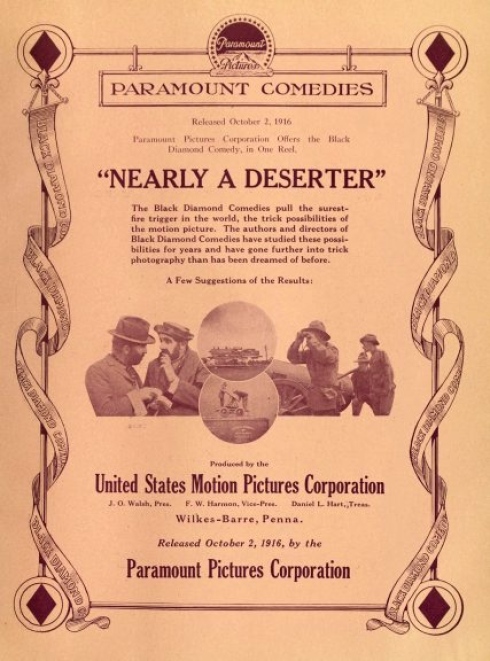
The first Paramount Pictures comedy, “Nearly a Deserter,” was filmed and produced by the United States Motion Picture Corp. of Wilkes-Barre.
With the surge in popularity of motion pictures in the early 1900s, studios began springing up along the East Coast, including in Northeastern Pennsylvania.
By the 1910s, Wilkes-Barre native Lyman H. Howe’s “high class” moving picture shows had been entertaining crowds for two decades, and his city-based studio pioneered aerial photography in 1911. Lackawanna County had the Scrantonia Photoplay studio, which in 1918 made short comedy films starring San Francisco-born Chinese actor Charlie Fang.
And Wilkes-Barre had the U.S. Motion Picture Corp., headquartered in the Savoy Theatre building on Public Square.
In October 1914, the newly formed company’s vice president Fred W. Hermann put out a call for investors:
“The plant will be located in Forty Fort at Wyoming Avenue and Slocum Street, where we have purchased a very valuable plot of ground,” Hermann stated in an October 1914 ad in Wilkes-Barre’s Sunday Independent newspaper.
“The main part of the building will be of brick and concrete, and the studio or stage almost entirely of steel and glass. The plant, when fully equipped, will be one of the most modern in this or any other country.”
James O. Walsh, a New Yorker, was president of the company. He was the one who interested local guys in the deal – and who had the money to back it.

Daniel L. Hart, an award-winning Broadway playwright, was one of the founders of the United States Motion Picture Corp. He was mayor of Wilkes-Barre in the 1920s.
Rounding out the trio was Daniel L. Hart, the company’s treasurer. Hart had already achieved a degree of fame as a playwright–his works include “Parish Priest” and “A Rocky Road to Dublin.” He would go on to become a popular four-term mayor of Wilkes-Barre.
So by fall of 1916, the U.S. Motion Picture Corp. had the financing, local talent and a brand-new, state-of-the-art studio in Forty Fort.
All the fledgling film company needed was a contract.
Auspicious start
Paramount Pictures, founded in 1912, contracted out the production of many of its motion pictures in its earliest days.
The company distributed the films to theaters around the country. Movie houses showed short subjects including comedies, newsreels and documentaries along with the main feature. And in 1916, Paramount needed some humor in the mix.
“Paramount Pictures Corporation will supply the last link in its chain by the addition of single-reel comedies each week to its program,” the trade magazine “Motography” announced in the Sept. 9, 1916, edition. “Contracts have been signed with the Klassic Pictures, Inc., producing the Klassic Komedies, and the United States Motion Picture Corporation, producing the Black Diamond Comedies.”
The first Black Diamond comedy was supposed to be issued on Sept. 25, 1916, but “Nearly a Deserter” didn’t hit theaters until October 1916.
Walsh boasted in the Oct. 21, 1916, edition of the trade publication “Motography” that, “With the advent of the Black Diamond ⦠there begins a new era in the making of the single-reel comedy.”
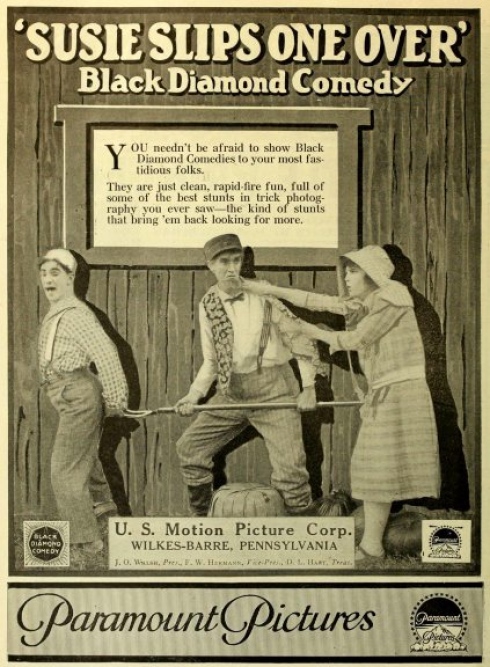
An advertisement for “Susie Slips One Over,” a United States Motion Picture Corp. Black Diamond Comedy released by Paramount Pictures.
The U.S. Motion Picture Corp. “worked out a process for trick photography, hitherto unknown to motion pictures,” Walsh wrote.
He didn’t divulge what it was, but noted, “The expense of filming some of the scenes ⦠is considerable, but we contend it makes little or no difference how much a picture may cost to produce if it pleases the public.”
In the first flush of success, Walsh undoubtedly didn’t realize those words would come back to haunt him.
For the rest of 1916 and all of 1917, the company churned out one-reelers at the rate of about one every two weeks. These were shot around the Wyoming Valley and used largely local – and uncredited – talent. The tall and portly Carl Dally was a repeat performer; so was diminutive Billy Thomas. Wilkes-Barre police Chief Russ Taylor was a cameraman.
Particularly striking is advertising for the second Black Diamond Comedy, “Bridget’s Blunder,” about a cook in love with a cop. It shows a car driving up the Luzerne County Courthouse steps.
“Her Fractured Voice,” one of the surviving Black Diamond comedies, features a scene shot in downtown Wilkes-Barre at the fountain in Public Square. The male lead – who likely was a local resident – runs down a side street to get there, to the amusement of passers-by who are more interested in the movie crew filming him.
Another location in “Her Fractured Voice” is Hillside Farms. “Many neighborhood kids were hired to act as extras, particularly in front of the old blacksmith shop nearby,” Mildred Newitt Hogoboom noted in a pamphlet on the history of Jackson Township.

A Still from “His Neglected Wife,” A United States Motion Picture Corp. comedy filmed at the Hotel Sterling in Wilkes-Barre.
An ad for the Palace Theater in Plymouth for Feb. 18, 1917, indicates the Black Diamond comedy “Braving Blazes” was filmed on South Street in Wilkes-Barre. Likewise, “Wits and Fits,” which showed at Plymouth’s Hippodrome the week of Sept. 16, 1917, featured “all local scenes.” “A Troublesome Trip,” released in November 1916, featured scenes shot on North Street in Wilkes-Barre and Wyoming Avenue in Kingston.
An apparent Black Diamond trick was to make a car look like it was driving on the surface of Harveys Lake. One of the lost comedies, “Their Counterfeit Vacation,” was shot there, Petrillo said.
“If I could find only one film from the company, it would be that one,” he said.
A later comedy, “His Neglected Wife” was filmed in part at the Hotel Sterling; the female lead signs in the register that she’s from Pittston, O’Connor said.
“It’s all local,” she said.
“People think they must be tacky, but they’re not – they were Paramount’s first comedies.”
The Black Diamond comedies proved popular, and an article in the July 7, 1917 edition of “Motography” reported that the U.S. Motion Picture Corp. was enlarging its studio, including an entire section devoted to the trick photography used in the comedies.
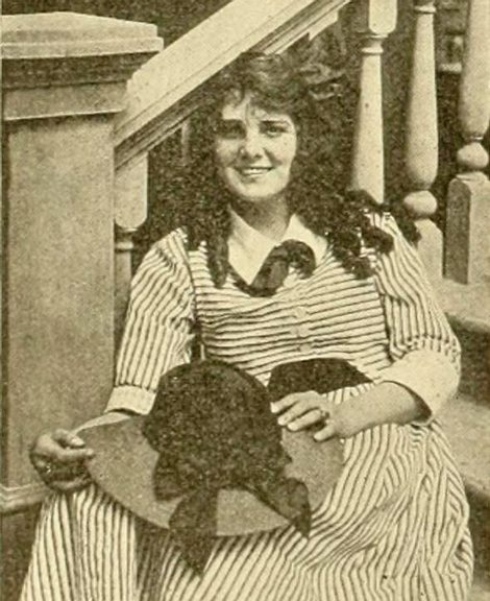
Actress Leatrice Joy appears in a promotional photograph in 1916 as she joined the cast of Black Diamond Comedies. Joy went on to become a successful Hollywood actress.
“During the past week additional players have been secured by the company which will surround Miss Leatrice Joy, the leading lady who has done clever work and won many admirers,” the article states.
The company established a script writing department that offered $5 per word for every idea of up to 50 words. They received more than 500 submissions.
Unfortunately, the optimism – and expenditures – were misplaced. The U.S. Motion Picture Corp. lost its Paramount contract.
The new studio didn’t materialize, and in 1918, the U.S. Motion Picture Corp. shifted to making Rainbow Comedies, distributed by the General Film Co.
The first of these was a World War I-related short called “Nearly a Slacker,” released in September 1918; another was “Hooverizing,” named for a popular World War I slang term that meant economizing, after Herbert Hoover (who was National Food Administrator at the time).
But by 1920, the U.S. Motion Picture Corp. was in decline. That year saw what was likely the last filming ever done at the Forty Fort studio: “A Woman in Grey,” a 15-part serial starring Arline Pretty.
End of an era
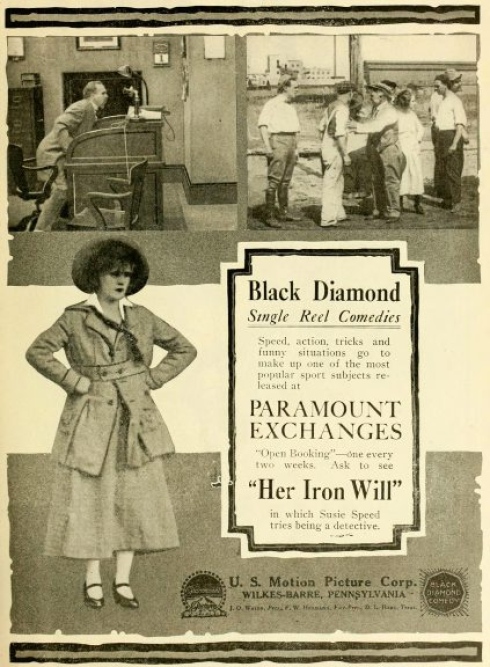 Post-World War I, the movie industry made an exodus to California, where the weather was more suitable for filming year-round.
Post-World War I, the movie industry made an exodus to California, where the weather was more suitable for filming year-round.
It was after 1918 that the U.S. Motion Picture Corp. went into a decline.
Why did the company fail? Petrillo speculates it was because the studio was underfunded and producing “relics of the silent era.”
“They were producing one-reel comedies, and the art of the silent movie had moved beyond these,” he said.
O’Connor noted that some of the Black Diamond players did go on to Hollywood, like New Orleans native Leatrice Joy who played Susie Speed, a recurring character. Joy, a versatile and talented actress, rose to silent movie stardom in Paramount features throughout the 1920s.
Another U.S. Motion Picture Corp. alumnus, Rex Taylor, who wrote the scripts for the Black Diamond comedies, went on to have a respectable career as a Hollywood scriptwriter.
After “A Woman in Grey” wrapped up, the Forty Fort studio sat idle for few years. The Sunday Independent reported its fate in a June 17, 1923 brief: “The Black Diamond motion picture studio in Forty Fort was sold yesterday to Albert Jones, a school director of Luzerne Borough. The new owner secured title to the property from Freedman and Dattner, who purchased the building and some surrounding ground a short time ago.
“It is the intention of Mr. Jones to convert the studio into a laundry. The building has not been used for picture purposes for several years.”
Jones did, but the “Do Right Laundry” was a washout.
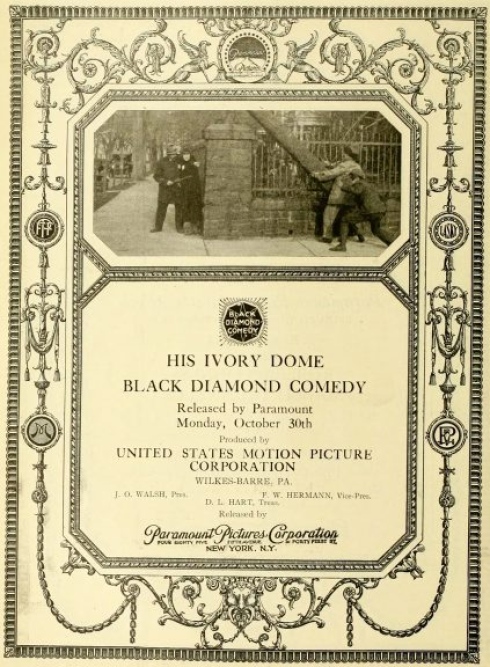 A Jan. 27, 1935, article in the Sunday Independent hinted that money troubles were at the root of the U.S. Motion Picture Corp.’s failure: “There would be no Fox or Lasky or Zukor here. There were to be, however, a few men with dented bank accounts – dented to the extent of $200,000.”
A Jan. 27, 1935, article in the Sunday Independent hinted that money troubles were at the root of the U.S. Motion Picture Corp.’s failure: “There would be no Fox or Lasky or Zukor here. There were to be, however, a few men with dented bank accounts – dented to the extent of $200,000.”
After years of neglect, during which kids broke the many windows with rocks and local men used the basement for poker nights, the studio was demolished.
Revival of interest
In the silent era, motion pictures were made on nitrate film, which was not only highly flammable, but also prone to decay and disintegration.
Petrillo estimates 70 percent to 80 percent of all silent films are lost due to deterioration, including most of the U.S. Motion Picture Corp. productions.
O’Connor discovered the U.S. Motion Picture Corp. through Luzerne County Historical Society Executive Director Tony Brooks, whom she had invited to talk to her New Media class about interesting people from the area.
One of the topics he mentioned was the local film industry.
O’Connor, a native Californian who always loved movies – particularly Charlie Chaplin’s – was intrigued.
“When Tony said there were these films, I said, ‘Tell me more.’ But he didn’t know any more,” she said.
So O’Connor obtained a summer grant from the Shoval Center at King’s and she and her class started researching.
“This project is one where you find a piece and you find a piece and you find a piece,” she said.
O’Connor’s students wrote articles compiled in a blog, blackdiamondcomedies.org, and put together material online for Wikipedia. The Wikipedia Black Diamond page didn’t exist until her students created it, she said.
Then O’Connor tried to track down the films themselves. The Black Diamond production “Her Fractured Voice,” starring Leatrice Joy, exists in San Francisco’s Prelinger Archives and can be viewed online at archive.org. But others are harder to find.
“What’s frustrating is not very many of them survived,” O’Connor said.
Unbeknownst to O’Connor, Petrillo had already been researching the U.S. Motion Picture Corp. Last fall they discovered they had the same idea and helped each other out.
Petrillo managed to unearth a copy of a U.S. Motion Picture Corp. comedy, “His Neglected Wife,” that turned up in a New Zealand archive in 2010.
He found it by “basically fishing around the Internet for any surviving films of the local company.”
In 1918, New York-based Inter-Ocean Film Corp. took on Black Diamond comedies for worldwide distribution.
These foreign markets did not send the movies back: it was too expensive and the films weren’t that valuable, O’Connor said.
As a result, far-flung places have films you can’t find anywhere else, she said.
 “His Neglected Wife” is now in the hands of the National Film Preservation Foundation in San Francisco, where it was restored before finding a permanent home at the Eastman House museum in Rochester, N.Y.
“His Neglected Wife” is now in the hands of the National Film Preservation Foundation in San Francisco, where it was restored before finding a permanent home at the Eastman House museum in Rochester, N.Y.
“They were kind enough to provide a copy to me,” Petrillo said.
It will be shown at a presentation O’Connor and Petrillo will give at Misericordia University on April 17, along with another film O’Connor discovered.
UCLA has most of the early Paramount Pictures holdings, including one of the Black Diamond films, “Susie Slips One Over,” featuring Leatrice Joy, O’Connor said. She ordered a copy.
Petrillo has a fourth U.S. Motion Picture Corp. movie, but he said it’s so badly deteriorated “you can’t really follow the film, and much of it is nearly unwatchable.”
O’Connor thinks more films may have survived. She received another grant to do research this summer.
“I still wonder if there isn’t something tucked away in an attic somewhere locally,” she said.
If you go: Local historian F. Charles Petrillo and King’s College English professor Noreen O’Connor will give a presentation on the U.S. Motion Picture Corp. and the production of short silent Black Diamond Comedy films in the Wyoming Valley at the Back Mountain Historical Society meeting, from 7 to 9 p.m. on Wednesday at Walsh Hall, Misericordia University, in Dallas Twp. Admission is free. Some of the surviving Black Diamond comedies will be shown.
eskrapits@citizensvoice.com, 570-821-2072
Original story at: http://citizensvoice.com/news/hollywood-on-the-susquehanna-1.1472659
and http://thetimes-tribune.com/news/wilkes-barre-movie-studio-gave-paramount-its-earliest-silent-comedies-1.1472696

The former USMPC site, as seen from the second floor of my home. A daycare and a pizza restaurant now sit on the site.
By Kellie LoGrande
History can be found anywhere, even in one’s own backyard. Run-down buildings, remains of landmarks, forgotten paths, and plots of land often have a story. All you need to do is find those forgotten things, and then maybe you can find the story behind them. The history of the United States Motion Picture Corporation runs through my hometown of Forty Fort, Pennsylvania, from filming locations to the site of the studio itself. In fact, the location of the now-demolished studio, located on the corner of Wyoming Avenue and Slocum Street, is adjacent to my backyard.
I’d never known what used to be there; one building had been a convenience store, then a Little Ceasar’s, and now a local pizza restaurant. A daycare sits directly behind it. There are few indicators of what could have been there before, if any; some of the garages look as if they could have been industrial, though I do not know when they were built. The stores and apartments nearby seem old, especially when you look at the unpainted brick. I’d known this town was very old. I had always attributed the age of the buildings to that alone, and did not wonder anymore.
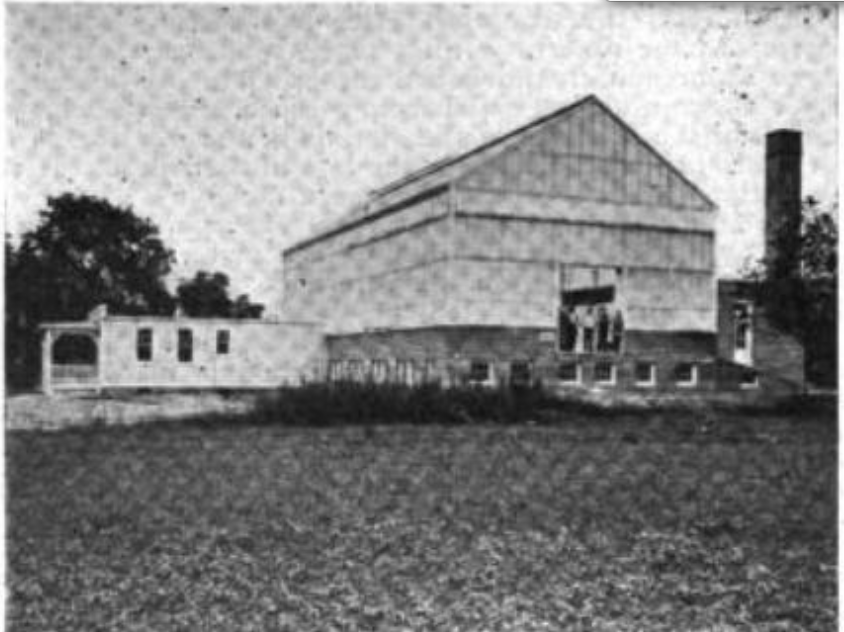
The United States Motion Picture Corporation studio, built in 1915, was located in Forty Fort near Slocum Street.
I hadn’t wondered for a long time, until I began to get involved with the history of the United States Motion Picture Corporation. That’s when I had found out that a major movie studio used to be where the convenience store–Little Ceasar’s–pizza restaurant and the daycare were now. I also found out that the USMPC filmed there, around the area of their studio.
As we watched His Neglected Wife — which features a railroad — for the first time, Charles Petrillo said to us, “We believe the railroad was on the corner of Murray Street and Slocum Street.” I knew exactly where that was. Furthermore, I knew that there was not one railroad there, but two: one which had been used until about a decade ago, and another which had clearly never been used for a very long time. The oldest railroad barely remains, obscured by growth; it seems to have been swallowed by the ground. I came upon it by accident one day, while taking a walk. A large tree had been growing between the rails, indicating that the railroad had not been used for a very, very long time. Should you walk down Slocum Street, next to a storage center, look on the ground; from the sidewalk, you can see the planks of the railroad, barely visible among the grass.

An old railroad. This could have been the railroad seen in His Neglected Wife.
The United States Motion Picture Corporation (USMPC) was one of the first silent film producers in the nation. More importantly to this post, it was located here in Wilkes-Barre and Forty Fort. Most people who live in this area don’t seem to realize that it was. To be honest, there are reasons for that. The legacy hasn’t been preserved as much as many would have liked.
Black Diamond comedies–one of which, Her Fractured Voice, was screened at King’s College on October 26, 2012–were produced mostly within our loc
al area by the USMPC and were distributed by Paramount Pictures. In fact, if you live, work, or go to school in Wilkes-Barre, you’ve probably walked past what was once the location of the Black Diamond headquarters and studio. Sadly, the building where much of their business was conducted work has since been demolished, but it was on Public Square, and used to stand where the Luzerne County Bank building is today.

Many of the relics of this era seem to have met the same fate. The filming studios for the USMPC, once located off Slocum Street in Forty Fort, were razed long ago as well. The Public Square fountain and streetcars that appear in Her Fractured Voice were replaced after hurricane Agnes in the 1970s, and the Sterling Hotel, which appears in another USMPC production entitled His Neglected Wife, is now condemned and slated for the wrecking ball this year. And while there’s at least one tantalizing structure in Wilkes-Barre with a Paramount Pictures logo embedded into the brick, this has nothing to do with the USMPC.
However, one particular building still stands. Lyman Howe was a major player in the local silent film industry, and his house still stands in Wilkes-Barre. It still looks the part of a Hollywood Mogul’s house, too. Stone lions guard the sidewalk leading up to building, and white pillars guard support the roof overhanging the main entranceway. Large, rounded windows give life to the expansive whitewashed walls. In short, if you’re looking to see a slice of this era in person, head to 30 Riverside Drive, Wilkes-Barre, PA.
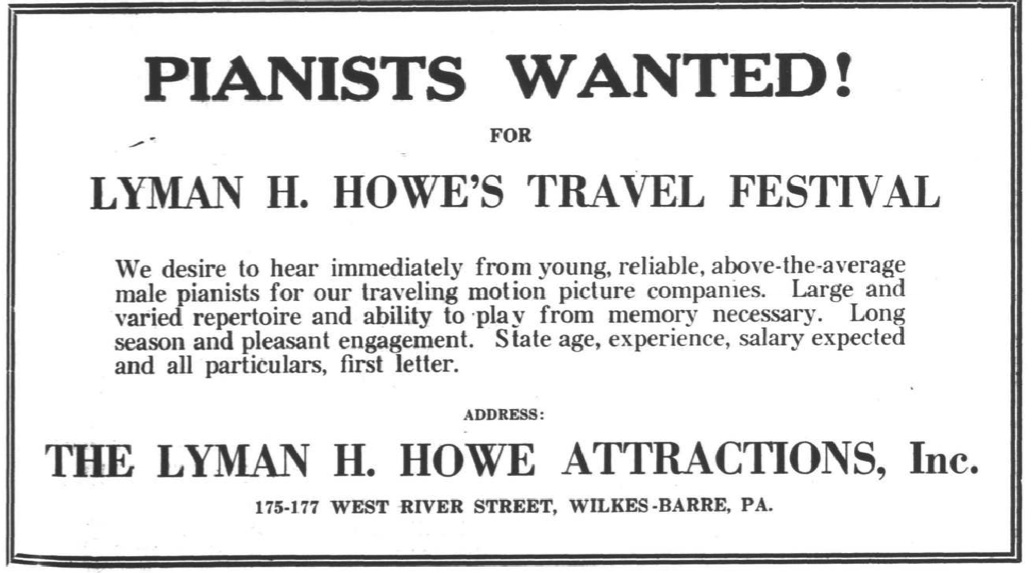
]]>
Like most college students my age, I had never seen a silent film prior to watching Flesh and Spirit for the film screening. When I learned that we would be watching and screening a silent film, I didn’t know what to expect. I had always just considered silent films to be boring and outdated, with very cheesy acting. After watching one silent film, I realized that were actually more interesting and enjoyable than I had always thought. It was a much different experience than watching a regular Hollywood blockbuster from today.
Since the silent film seemed to actually be interesting, I decided to try to view some other silent films as well to see if they still held any appeal. I watched some old silent films starring Charlie Chaplin. I was surprised by how funny the movies were. They tended to use a more exaggerated style of acting that makes the plot as easy to follow as it would if the characters were speaking and had spoken lines. The actors and actresses are very skilled at portraying their emotions through body language and facial expressions. It is incredible how much they were able to communicate without saying a single word. Also, it was much easier than I had anticipated to be able to follow the plot and enjoy the movie.
After I learned that silent films used to be accompanied by live music, I was curious to see how that would change my silent film experience. During our screening of Her Fractured Voice, His Neglected Wife, and Flesh and Spirit, music was provided by “Dos Noisemakers.” With the musical accompaniment, the silent films were much easier to follow. It was very similar to a soundtrack for a movie or television show: the music would pick up during action scenes and slow down to draw out suspense. I am very grateful to have had the opportunity to give silent films a chance and to appreciate a lost art of acting. I now have a new and very surprising appreciation for the lost art of silent films.
]]>
The United States Motion Picture Corporation film His Neglected Wife, produced about 1918, is set at Wilkes-Barre’s Hotel Sterling.
As I walked down North River Street with friends on the day that I first arrived in Wilkes-Barre, I came across a massive decrepit building. I looked up and thought to myself, “How someone could let such an amazing building become so worn is astonishing.” I enquired about what the building was and on finding out that it was the “famous Hotel Sterling,” I wondered if it was another victim of the recent recession that had hit most of the western world pretty hard.
Coming from a modern European city like Belfast, I am not used to seeing old fashioned hotels like the Sterling. Most of the hotels in urban Belfast are built with a modern feel. But when I look at the Sterling, even in today’s condition, it looks like it was a classy establishment, the kind of hotel where the staff would be proud to tell people that they work there, a place where the guests would know that they were living in luxury. The whole place oozes class.
After my first day explorations, though, I forgot all about the hotel and went about my business as a study abroad student. It wasn’t until Dr. Noreen O’Connor showed us the silent film His Neglected Wife that I thought about the old building again.
The hotel plays a big part in His Neglected Wife, a one-reel comedy that was filmed in Wilkes-Barre about 1918. In the film, the leading lady runs away from her husband, who tended to favour his career over her needs, and finds herself escaping to the Hotel Sterling.
After watching His Neglected Wife I decided to look into the hotel a little bit more. I didn’t have to look far in order to find out some information about one of Wilkes-Barre’s famous landmarks. A quick internet search helped me discover how well-thought-of the Sterling was in the local community. There were protest pages and others just showing support for the historical building. The people of the city realize how important the hotel was during the twentieth century. People look at the building with a sense of pride and it’s obvious that a lot of people would snap it up in a heartbeat and rebuild it to its former glory if they had the money to.
Unfortunately, in this day and age, money just isn’t readily available for historical restorations on such a massive scale. The Sterling now seems to have been condemned to be demolished despite the local protests. Groups have tried to encourage investors to take over the burden of reinventing the hotel and it nearly happened just a few years ago when the non-profit organisation CityVest planned to restore the original Sterling building and reopen to the public. However the plan fell through once it became clear how much of a mammoth task they faced. After it became clear that their restoration was impossible the group decided that the best option for the building would be to demolish it.
More research showed that the hotel was used by lots of famous politicians over the years. The most famous of the hotel’s guests has to President John F Kennedy, who stayed there during the early 1960’s. This is very impressive to someone from Northern Ireland because JFK is perhaps the most famous modern day (to an extent) president and throughout Europe most people are aware of his presidential tenure and of course his tragic fate.
It seems now though that the Hotel Sterling has been condemned to a similar fate as that of the late President Kennedy. It is expected to be demolished in the near future and then it will be alive only in the memories of those who stayed there or the people of Wilkes-Barre. It will however be written into the history books as one of the city’s famous landmarks and going by the general consensus around the King’s College campus and even the city as a whole, the day that the Hotel Sterling is knocked down will be the end of an era and the look of the Susquehanna River front will be changed forever.
]]>
The second Paramount Black Diamond Comedy, filmed in Wilkes-Barre by the United States Motion Picture Corporation, features recognizable landmarks including the Luzerne County courthouse.
When I first began the silent film portion of my Writing for New Media course, my mind instantly went to Charlie Chaplin and Buster Keaton. After taking a film course my senior year of high school, I took an extreme interest in film. We briefly touched on silent films, So I did not have extensive knowledge on the topic, but I had a base. I was immediately fascinated by them. When Dr. O’Connor announced that we would be studying silent films, and also putting on an event involving them, I was very excited.
The thing that amazed me most about the course material was the fact that our very own Wilkes-Barre, Pennsylvania, was a hot bed for films and motion pictures in the early1900’s. Although I love this city dearly, I was astonished at the thought of Wilkes-Barre being a breeding ground of fame and stardom. Picturing Wilkes-Barre as “Hollywood-esque” was difficult for me to wrap my head around. Many stars, such as Leatrice Joy from “Her Fractured Voice,” went on to Hollywood after her tenure in Wilkes-Barre. Clearly, the industry exploded in size and moved west to Hollywood—exploded to a size that Wilkes-Barre could no longer house. However, it is a fascinating part of our city’s culture that is, in my opinion, not widely or commonly known in our area.
I decided to put my opinion to the test. I wanted to see just how big of a secret this was to our city’s current community. I began by conducting interviews on the campus of King’s College. Since most students have not resided in Wilkes-Barre their whole lives, I decided I would also venture into the heart of Wilkes-Barre, Public Square, as well.
I posed the question to all three students from King’s the same way. “Do you know if Wilkes-Barre has a history of being a part of films/motion pictures?” All three students seemed baffled by my inquiry. When I then explained how prevalent it was in Wilkes-Barre, the students were shocked. One student replied with, “Yeah…okay bud,” and walked away. However, to my surprise, each student was from a surrounding city of Wilkes-Barre. If they didn’t know, how would a student that hails from New Jersey or New York know?
It was time to broaden my search. I thought that at least one individual would have had an idea, but I was surely mistaken. “That must have been a long long time ago,” said one citizen. “I knew this downtown area was bustling back in the day, but I had no idea about the film aspect. That’s pretty cool.” Out of the seven civilians that I approached, that was the closest I got to a person who knew of Wilkes-Barre’s past.
It turns out that I was not in the minority when I was surprised at the news of Wilkes-Barre’s film background. Hopefully, this will change—it is too good to keep a secret. I am glad my class, Dr. O’Connor, and Tony Brooks are doing our part to spread the word. Hopefully we, along with inspiring others, can shed some light on this aspect of our city’s history.
]]>
Advertisements for Paramount Pictures’ early silent film comedy stars, Fatty Arbuckle and Leatrice Joy
By Ashley Mayberry
Like most 20 year olds today, I have never been exposed to silent films. I have only ever seen films with dialogue and I did not have a particular interest in silent films. Also, silent films seem to have been forgotten because of the how advanced movies are today. This semester I am taking two media courses which have opened my eyes to the world of silent films.
Silent films are able to draw viewers in without a script. They use music, facial expressions, interactions with other characters, and humor to make it a story worth watching. Films from this era have the ability to wow audiences without words, which is something today’s films lack.
While watching more silent films than I ever have before, I have also been wondering what the films I watch today would be like if they were silent. Silent films are silent, so I can follow the story line by merely seeing the film, not hearing it. In some of my favorite movies of today I do not think they would be the same without sound.
All of today’s movies are centered on dialogue. In fact, a lot of people quote humorous lines from movies. You have probably fit a line from a movie into your everyday conversation as a sort of comic relief. These quotes make people laugh because the movie they are coming from is funny. I believe that audiences find today’s comedies entertaining mostly because of what the characters are saying, not the events of the actual movie.
To test this theory I decided to watch a popular movie from this era with the sound muted. I chose Mean Girls because it is a fairly popular film from our time that most people can summarize. Also, the plot is fairly basic, so most viewers have no trouble following it. I admit that this is one of my favorite movies and I do happen to quote the movie from time to time.
After my experiment, I have concluded that this movie is fairly dull with no dialogue. The reason that this movie has received such high ratings is simply because the dialogue is humorous. Without the banter, jokes, and quirky phrases this movie is nothing special. Actually, the plot itself is ultimately boring. A new girl does not fit in, she becomes popular, becomes unpopular, and then she turns into a good person. This is not exactly the most stimulating comedy.
For example, in one particular scene the main characters are at a party. The girls are dressed up in a crowded room, talking to each other, and holding drinks. It does not sound interesting in the slightest when the sound is off. However, this scene is actually funny because of what the characters are saying. Gretchen, played by Lacey Chabert, is trying to explain to Karen, played by Amanda Seyfried, the concept of cousins because Karen likes a boy who is her first cousin. Karen backs herself up by saying, “So, you have your cousins, and then you have your first cousins, and then you have your second cousins…” Obviously this scene is funny because the character sounds like an airhead.
If this film did happen to be a silent film, this particular scene would have been much more comical with a more animated actress, such as Lucille Ball. She could have walked up to the boy and acted out a flirtatious encounter by talking to him, laughing, and touching his arm. Her friend would then come over and dramatically drag her away to have a serious conversation with her. Then Lucille would give a confused look, shrug her shoulders, and shake her head. The viewer would still get the impersonation that Lucille should not be flirting with this boy because of something her friend told her. Even without words, the viewer will still understand the basic point of the scene.The point I am trying to make is that most films today rely on sound to impress audiences. If you mute the sound, you are simply watching a character go through meaningless motions. The dialogue is what makes the movies noteworthy because, without sound, the characters are basically standing around. My opinion is that even though actors in silent films had a more difficult time relaying a story, they still did a better job than actors of today because they were able to tell a story through physical movements instead of words.
]]>


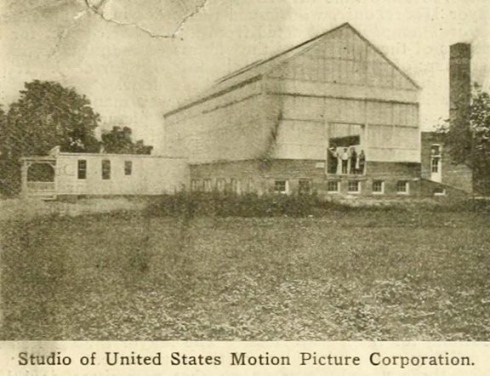



![Lucille_Ball[1]](http://blackdiamondcomedies.com/wp-content/uploads/2012/11/lucille_ball1.jpg?w=235)